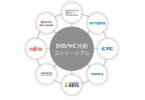At this week’s Blockchain in Insurance Summit in Philadelphia, one of the panels was entitled “evaluating alternative collaboration models”. On the podium there was much talk about consortia and blockchain being a team sport. Only the event chair Dante Disparte publicly disagreed saying business is about competition.
In private discussions, those new to blockchain were more skeptical about competitors working together and were surprised to see State Farm and Nationwide sitting side-by-side on the podium. Nationwide’s Mike Fulton acknowledged that initially he had internal pushback along those lines when discussing joining the RiskBlock Alliance. But it was clear from the talk that many companies have embraced the consortia participation and are seeing the advantages.
Benefits
The obvious outcome from consortia is developing shared solutions. In the case of RiskBlock, that’s the proof of insurance and first notice of loss applications that are due to launch early next year.
For Nationwide one of the biggest benefits has been learning and exploring appropriate use cases. “Trying to dig into the use cases in the insurance industry, at least what makes sense and what doesn’t, has been a really interesting part of the journey for us,” said Fulton.
Sitting next to Fulton, Dustin Helland Product Innovation Manager at State Farm sees momentum as key. “Looking outside your walls and being able to identify specifically other companies that are engaged, we found is one of the mechanisms to help create that type of momentum and create a sense of urgency.”
Robert Mozeika, from Munich Re said the consortia provide access to talent, resources and education which might be challenging to achieve internally. In the case of RiskBlock, it has a “software factory” of five consultants: Deloitte, IBM, Cap Gemini, Accenture, and EY.
Talking to RiskBlock members during the breaks it became clear that the initial cost of membership was substantially less than hiring one coder. Even next year’s membership subscription for the largest players is only roughly the cost of a Silicon Valley developer.
Figuring out a strategy
Fulton highlighted the low risk: “We’re sharing the learning, we’re sharing the risk, we’re sharing the investment.” He explained it made it easier for the leadership to commit to the investment and continued: “When I look at blockchain I see a technology that will be truly transformational to our industry over the long term. Investing a little bit upfront to make sure we understand the implications and we can know where to put down the bigger bets a year or two down the road is to me a really important aspect to this.” But he’s not ready to identify a strategy quite yet.
State Farm’s Helland echoed similar sentiments. “The thought process is more on what are we learning and how are we gaining towards identifying opportunities with real business value and real ROI.”
Both Nationwide and State Farm were keen to avoid using ROI as a metric at the learning stage. Helland pointed out that while Bitcoin may be ten years old, all the major private permissioned technologies – Hyperledger Fabric, Corda and Quorum – only had their first full releases last year.
Day of reckoning
Although acknowledging the immaturity, Munich Re’s Mozeika thinks the day of reckoning is nigh. He sees 2019 as a critical year because by then corporations will have been experimenting for one or two years. “I think this is at that crossroad right now. To continue these efforts, show me the value.”







